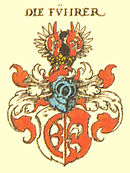- Christoph von Fürer-Haimendorf
-
Christoph von Fürer-Haimendorf or Christopher von Fürer-Haimendorf (1909 Vienna - 1995 London) was an Austrian ethnologist. He spent about forty years of his life doing fieldwork in Northeast India and in the central region of what is now the state of Andhra Pradesh and in Nepal.
Contents
Biography
Christoph von Fürer-Haimendorf was born in an Austrian aristocratic family. Very early he developed an interest in Indian culture, having read Rabindranath Tagore as a young man. He studied anthropology and archaeology in Vienna and was most influenced by Robert von Heine-Geldern. He made his thesis on the tribal social organization in the Naga Hills.
After his thesis, von Fürer-Haimendorf moved to London in order to establish contact with the main athropologists of his time, like Bronislaw Malinowski. By 1936 he travelled to India, where he worked among the Naga people and established good friendships among the local administrators of the British Raj. After five months and great effort, Christoph succeeded in learning the local language and was able to do without an interpreter. From then onwards von Fürer-Haimendorf would proclaim that it was of the utmost importance for an ethnologist or ethnographer to learn well the language of the people who were the subject of the fieldwork in order to be competent in his or her studies.
In 1938 von Fürer-Haimendorf married Betty Barnado, a companion worker. At the time he only made a brief visit to Europe and returned to India, so that at the outbreak of World War II he found himself in British territory holding a Third Reich passport. He was arrested by the colonial authorities, but with a great degree of politeness and sadness, for they were good friends of his. Thus he was confined to Hyderabad State in South India. As time went by von Fürer-Haimendorf earned the trust of the local authorities, who could see that he had no Nazi sympathies. He was then able to do some of his best fieldwork ever while living among the Chenchu, Bhil, Reddi[1] and the Raj Gond Adivasi of present-day interior Andhra Pradesh.
Thanks to friendly government officers, which included fellow ethnologist Verrier Elwin, von Fürer-Haimendorf was able to obtain a post as Special Officer and Assistant Political Officer to the North East Frontier Agency, so he could move back to Northeast India. He studied the Apatanis in 1944-45, when there were tensions in the area owing to the Japanese conquest of Burma.
When the war was over von Fürer-Haimendorf was named Advisor for Tribes and Backward Classes to the Nizam's Government of Hyderabad and returned to the South where he continued to do ethnograhic fieldwork while he was engaged as government officer. In 1953, when the Kingdom of Nepal opened to the outside world, Cristoph didn't want to lose the opportunity to visit the then little-known country and became the first foreigner who was able to do research among the peoples of Nepal.
Christoph von Fürer-Haimendorf lived his old age in London, where he became professor of anthropology at the School of Oriental and African Studies. In 1987, following the death of his wife Betty, his health suffered a decline from which he didn't recover. Christoph von Fürer-Haimendorf was buried in London.
Works
Von Fürer-Haimendorf published 3,650 pages of ethnographic notes and took more than 10,000 photographs[2]. He also shot a total of over 100 hours of 16 mm documentary films, giving a glimpse on the way of life of certain little-known cultures that were poised to change irreversibly.
- Published writings:
- The Chenchus (1943)
- The Reddis of the Bison Hills (1945)
- The Raj Gonds of Adilibad (1948)
- Morals and merit (1967)[3]
- The Sherpas of Nepal (1964)
- The Bagoria Bhil (1964)[4]
- The Konyak Nagas (1969)
- Return to the naked Nagas: an anthropologist's view of Nagaland 1936–1970 (1976)
- The tribes of India: struggle for survival (1982)
- Films:
- The Men Who Hunted Heads (1970)
- The land of the Gurkhas (1957)
- The land of Dolpo (1962)
See also
References
- ^ Konda Reddis
- ^ Review: Christoph von Fürer-Haimendorf, Life among Indian tribes: the autobiography of an anthropologist, Oxford University Press, Delhi, 1990
- ^ Christoph von Fürer-Haimendorf, Morals and merit: a study of values and social controls in South Asian societies
- ^ Christoph von Fürer-Haimendorf, Matthias Hermanns, Die religiös-magische weltanschauung der Primitivstämme Indiens. Band I. Die Bhagoria Bhil. Franz Steiner Verlag. Wiesbaden 1964.
- Alan Macfarlane & Mark Turin, Professor Christoph von Fürer-Haimendorf 1909-1995, Bulletin of the School of Oriental and African Studies, University of London, vol.LIX, pt.3 (1996)
- Review: Christoph von Fürer-Haimendorf, Life among Indian tribes: the autobiography of an anthropologist, Oxford University Press, Delhi, 1990
- Ralf Meßner, Christoph von Fürer-Haimendorf: Die Stellung der Naturvölker in Indien und Südostasien.
External links
- Fürer-Haimendorf Collection
- The Fürer-Haimendorf Archive
- Furer-Haimendorf Digital Archive Cine film, photographs and written journals of tribal cultures in South Asia
- The Fieldwork of Christoph von Fürer-Haimendorf
Categories:- Andhra Pradesh
- Northeast India
- Austrian anthropologists
- Travel photographers
- Visual anthropologists
- Ethnographers
- Ethnologists
- 1995 deaths
- Published writings:
Wikimedia Foundation. 2010.

